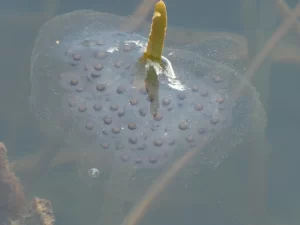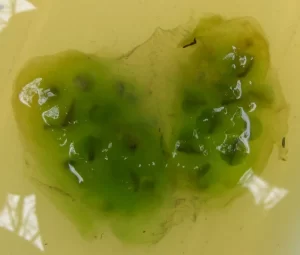When the winter ends, and the warm and wet spring weather comes, salamanders emerge from hibernation and migrate to ponds to mate and lay their eggs. But what do salamander eggs look like?
Salamander eggs look somewhat like frogs eggs. They are laid in masses and attached to submerged plants near the water surface. Unlike reptile or bird eggs, salamander eggs do not have a hard outer shell. Rather, they have a layer of jelly surrounding the entire egg mass.
This jelly is usually clear or cloudy white but can be slightly different colors depending on the salamander species. It can be brown, cream-colored, or even have a bright green glow from algae.
Some salamanders such as the red-backed salamander lay their eggs in moist soil on land, rather than in the water. These eggs do not have a protective layer of jelly. Rather, they have soft egg sacks and are covered in slime to protect them from the elements.
Most Salamanders Lay Their Eggs in the Water
On the first rainy night of spring, when the temperatures are hovering around 40-50°F, thousands of salamanders and frogs emerge from their overwintering spots and migrate to breeding ponds. This mass migration is often referred to as “the big night”.
During this migration, salamanders will travel up to half a mile to reach deep enough pools of water where they can lay their eggs.
Most salamanders strongly prefer to breed vernal pools (seasonal fishless ponds, usually formed from snow-melt), but may also breed in ponds, deep tire tracks, and even roadside ditches.
During courtship, the male salamander deposits a packet of sperm on the pond bottom and tries to draw the female over the top. The female salamander then picks up sperm packed with her cloaca and fertilizes her eggs internally.
After a few days, the female lay three to four egg masses and attach them to submerged vegetation or on the underside of submerged rocks near the water surface. Depending on the species, the egg masses can have anywhere from 30 to up to as many as 250 eggs.
Here Is What Aquatic Salamander Eggs Look Like:





When the eggs are laid, they are embedded in special secretions from a gland in the salamander’s body. These secretions combine with water to create a jelly-like coating around the entire egg mass.
The jelly is usually clear or cloudy white but can be slightly different colors depending on the salamander species. It can be brown, cream-colored, or even have a bright green glow.
The jelly protects the eggs from drying out if the water level in the pool drops. It also protects them from predators such as the eastern newt.
Algae Give Some Salamander Eggs a Bright Green Glow
Although the jelly surrounding the egg mas is important to protect the eggs, it often creates another problem: Oxygen.
The embryos need to breathe as they develop. However, the jelly does not allow oxygen to diffuse in and carbon dioxide to diffuse out. This can suffocate and kill the embryos before they fully develop.
To get around this, salamanders such as the spotted salamander have developed a symbiotic relationship with a special type of algae known as Oophila amblystomatis (which means “loves salamander eggs”).
The algae grow and bloom inside each egg. They then absorb carbon dioxide and other waste produced by the embryo and produce oxygen through photosynthesis. In this way, the embryo gets all the oxygen it needs for proper development.
However, as a side effect, the algae gives the salamander eggs a bright green glow.

In the past, scientists thought the algae only grew in the Jelly of the eggs. However, a 2010 study discovered that the algae also lives inside the cells of the salamander embryos as they develop. This is the only known case where algae grow inside the cells of a vertebrate.
Some Salamanders Lay Their Eggs on Land
Salamanders such as the arboreal, and the red-backed salamander lay their eggs on land rather than in the water. This could be in moist soil, in damp rotting logs, in damp leaf litter, on the roof of a rock in a moist environment, or even at the base of a tree branch high up in the forest canopy.
Unlike salamander eggs laid in the water, salamander eggs laid on land do have a layer of jelly surrounding the egg mass. Rather, the individual eggs have soft membrane-like egg sacks to protect them from the elements.
Also, terrestrial salamander eggs are usually laid in much smaller masses than aquatic eggs. Some salamanders may lay as few as only 6 eggs.
Here Are Some Pictures of Terrestrial Salamander Eggs:


The female salamanders will usually remain coiled up around their eggs, to protect them from predators and prevent them from drying out.
How Long Does Do Salamander Eggs Take to Hatch?
The eggs laid by most salamander species will hatch after about three to four weeks. However, this will vary depending on the specific species, and the environmental temperatures. Some salamander eggs may hatch after only a week, while others may take up to two months before they hatch.
Here are some pictures of salamander eggs that are close to hatching:


After hatching, the larvae (baby salamanders) will typically live a fully aquatic life, just like frog tadpoles, until they transform into adult salamanders and leave to water.
What Baby Salamanders Look Like After They Hatch
The newly hatched larvae of most salamander species will live entirely in the water and look somewhat like frog tadpoles. They have external wing-like gills attached to either side of their heads, just where their necks should have been.
They also have a flat paddle-like tail fin that runs down the length of their body to help them swim in their aquatic environment.
Here are some pictures of baby/larval salamanders:




These larvae will stay in the water munching on small worms and other small aquatic invertebrates to grow and get ready to transform into adults through a process known as metamorphosis.
Salamanders that lay their eggs on land have no aquatic larval stage. The eggs hatch into tiny salamanders that look just like smaller versions of the adult salamanders.
During metamorphosis the larvae will go through the following:
- Their gills will shorten and eventually be absorbed into the head
- They may develop lungs for breathing air (some adult salamanders do not have lungs, they breathe entirely through their skin)
- They develop strong legs for walking long land
- Their flat tail will shorten and become more rounded
Once this process is fully complete, the larvae will transform into adult salamanders that most people are more familiar with.
Salamander Eggs vs Frog Eggs: How to Tell Them Apart
Amphibian eggs, especially those laid in the water can be difficult to tell apart unless you have a close eye to watch for differences. It is possible to mistake salamander eggs for frog eggs, and vice versa.
The easiest way to tell the difference between salamander eggs from frog eggs is to look at the outer layer of the egg mass.
Frog egg masses have an outer layer that is made up of the eggs themselves, while salamander eggs masses are surrounded by an outer jelly coat.
If you took a close look at a frog egg mass, you would easily notice the contour of each individual egg outside of the egg mass.

Here is another picture showing what frog eggs look like in a puddle of water:

With salamander eggs, you would not see any contour since the entire egg mass is covered in an outer layer of jelly. However, if you looked very closely into the jelly, you would see the outline of each egg within the mass.

Here is a closeup picture clearly showing a salamander egg mass covered in an outer layer of jelly:

Also, salamander eggs tend to be denser and hold together, while frog eggs tend to be looser.
If you picked up a salamander egg mass, the outer layer of jelly would hold the entire egg mass very firmly together. However, if you picked up a frog egg mass, the eggs would fall apart more easily due to the lack of outer jelly to support the egg mass.
Here Is What Frog Eggs vs Salamander Eggs Look Like When Submerged in a Pond:

On the frog egg mass, you can see the contour of the eggs on the outer part of the mass even when submerged in water. The outline of the outer layer of jelly is visible even on the submerged salamander eggs.
Related Questions:
Question: Do All Salamanders Lay Eggs?
Answer: The vast majority of salamanders lay eggs, but salamanders such as the fire salamander give birth to live young.
The embryos develop inside their eggs inside the mother salamanders body. They hatch inside her body at the moment of birth.
The newly hatched salamanders are born as well-developed aquatic larvae. This is known as “ovoviviparity“.
Alpine salamanders are another species of salamander that gives birth to live young. However, unlike fire salamanders, alpine salamanders give birth to fully metamorphosed young that live a terrestrial life from the moment of their birth.
Question: How Many Eggs Do Salamanders Lay?
Answer: Depending on the species, salamanders can lay anywhere from 6 to up to 500 eggs at a time.
However, salamanders that lay eggs on land will always have fewer eggs than those that lay eggs in the water.
For example, the marbled salamander can lay as many as 500 aquatic eggs at a time. The arboreal Salamander, on the other hand, lays no more than 30 terrestrial eggs at a time.
Question: What Animals Eat Salamander Eggs?
Answer: The main predators of salamander eggs are fish, frogs, newts, large salamander larvae, and adult salamanders. Also, many salamanders will often eat many of their own eggs after they have laid them.
Final Thoughts
Many salamanders lay eggs, but not all do. The salamanders that do lay eggs usually lay them in the water.
These eggs are laid in masses, and you can easily identify them by the jelly coating covering the entire egg mass. This jelly is meant to protect them from the elements and predators.
The salamander eggs laid on land do not have a protective layer of jelly, and instead, have soft membrane-like egg sacks covered in slime to protect them from the elements.
If you ever come across aquatic amphibian eggs and aren’t sure whether they belong to a frog, or salamander, just look at the outer layer of the egg mass.
If it has a protective layer of jelly, they are salamander eggs. If it is not covered by a layer of jelly, and you can see the contour of each individual egg outside the egg mass, they are frog eggs!
Image credits: Corey Raimond/flickr. Tristan Schramer/flickr. Pierson Hill/flickr. Kevin Price/flickr. Steven Johnson/flickr. Charles (Chuck) Peterson/flickr. Tilebreaker/flickr. Peter Granka/flickr. Marshal Hedin/ Wikimedia Commons. Greg Scechter/ Wikimedia Commons. Susan/flickr. Emily Flint/flickr. Denise Riddle/flickr

